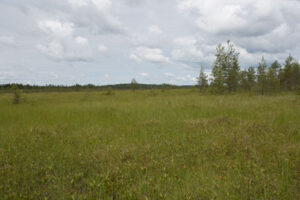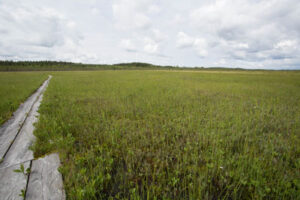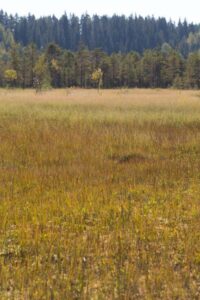Suurisuo
You can explore Suurisuo mire effortlessly along the boardwalks that lead into the heart of the mire. The valuable Suurisuo, part of the Natura network, is one of the most significant mires in Southern Häme. The mire complex represents southern Finnish raised bog, but it also has features of aapa bog. In a raised bog, the center of the mire is elevated, nutrient-poor, and dependent on rainwater. Nutrient-rich waters flow to the edges of the swamp, which is reflected in the lusher swamp types along the margins. The mire exhibits typical swamp types found in southern Finnish raised bogs, which are marked with posts as well as described in the brochure and on the website. The nature of Suurisuo mire is diverse, with forests along the edges and a middle part that is open bog. Suurisuo is home to several endangered and rare plant and insect species, as well as birds. There is also a birdwatching tower and excellent berry-picking areas.

This page presents the nature of Janakkala’s Suurisuo mire, where you can explore the various points of the nature trail in the mire. Janakkala Suurisuo mire is located on the northern side of road 292, about 13 kilometers northeast of Turenki. Suurisuo mainly consists of raised bog, with its center elevated compared to the edges. At times, there are also features of a aapa bog in Suurisuo. Especially in spring, the open watery southern part resembles northern Finnish aapa bogs.
The nature of Suurisuo is diverse. The edges of the mire have forests and pine fens. The center is an open bog, with nutrient-rich fen and sedge types, as well as nutrient-poor low-statured fens. Suurisuo was originally protected by a decision of the management board of the forest company UPM’s predecessor Rosenlew in the early 1960s. Since then, it has been included in the Basic Program for Mire Protection and subsequently as part of the Natura network. The landowner of the area is UPM, and the area of the Natura site is 232 hectares. The area is also an important destination for education, research, and hiking. The University of Helsinki has used the mire in its teaching since the 1970s.
Directions: You can reach the starting point of the nature trail by turning north from road 292 (Lammintie) to Suurisuontie on the east side of the mire. After just a few hundred meters, the road curves left, and you arrive at a turnaround point. There is also space to park at the turnaround point.
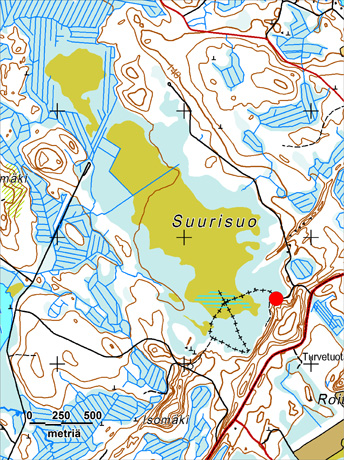
The trail begins from a peninsula extending into the mire. The edge of the mire, where it meets mineral soil, is usually wetter than the central parts. Various types of swamp forests (korpi) develop on these shallow-peat marginal areas. In this section, there used to be fen-like swamp forest (nevakorpi), which gradually transitions into pine-dominated bog (nevaräme) as the peat layer thickens.
Suurisuo is a very old mire, likely formed shortly after the last Ice Age. This long development means that much of the swamp forest along the edges has already turned into bog forest (räme). Some open pools (allikot) remain, with water likely fed by springs located on the eastern edge of the mire.
At the edge of the mire grows common reed (Phragmites australis), indicating the former shoreline of an ancient lake and the presence of only a thin peat layer. As you move toward the center of the mire, the reed disappears. Other common edge species include crowberry, mare’s-tail, bogbean, and star sedge.
Bog features include large, raised hummocks covered with reddish sphagnum moss, Scots pine, and crowberry.
Fen-like features of the mire include the wet, low-lying hollows between hummocks, where you’ll find species such as narrow-leaved sphagnum, wire sedge, star sedge, and bogbean.
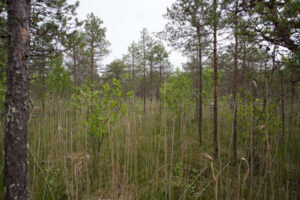
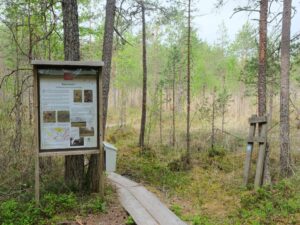
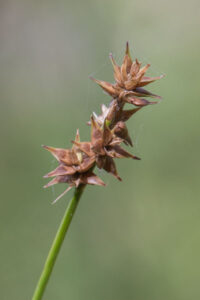
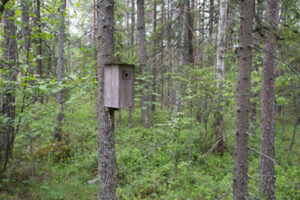
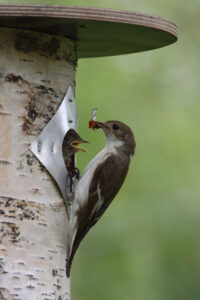
At this point, a small patch of spruces grows — this is a spruce-dominated bog forest (korpiräme). Alongside the spruces, you’ll find downy birches, bilberry, cloudberry, and mosses such as plagiomnium moss, which is common in this area. Among the bog species is the delicate few-flowered sedge (Carex pauciflora).
In the photo below, you can clearly see the large green leaves of the cloudberry, bilberry twigs, and a dense carpet of sphagnum moss.
The edges of the mire are also a favorable habitat for moose. Although spotting a moose during the day can be difficult, you can often see hoofprints and droppings scattered around. Well-worn moose trails are also visible in parts of the mire, some leading toward the open bog.

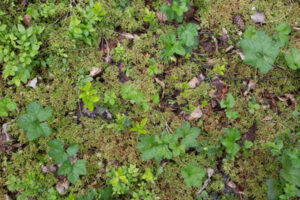
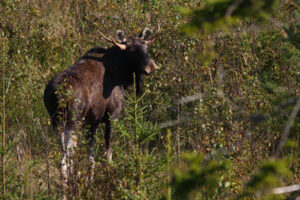
Extensive areas of pine-dominated bog (nevaräme) can be found along the eastern edge of Suurisuo. Wire sedge and bogbean are among the most common plant species in this habitat. Other plants in the area include marsh rosemary, great and small cranberries, and wild rosemary growing beneath the pines. You’ll also spot dwarf birch shrubs, about knee-high, scattered here and there.
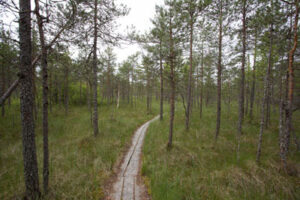
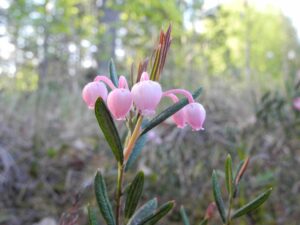
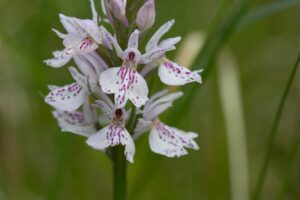
Unlike many of our other native orchids, the heath spotted orchid (Dactylorhiza maculata) thrives in a wide range of habitats. It is most abundant in moist, calcareous forests and along the edges of mires. The flower color can vary from deep reddish-purple to nearly white, and the leaves are marked with dark spots. The inflorescence is delicately cone-shaped—compare this to the marsh orchid (Dactylorhiza incarnata), which has a more robust, oval-shaped flower cluster. The heath spotted orchid also has a more slender stem than the marsh orchid. Marsh orchids can be found in the open mire around Checkpoints 5 and 6.
The undersides of bog rosemary (Andromeda polifolia) leaves are very pale, while the upper sides are bluish-green. This makes the plant easy to identify even when it’s not in bloom. The pale pink, bell-shaped flowers appear at the tip of the stem in June.
The leaves of dwarf birch (Betula nana) are round with finely toothed edges. This low shrub typically remains knee-high or smaller. In autumn, its leaves turn brilliant shades of red and yellow, contributing to the vibrant fall colors of the mire.
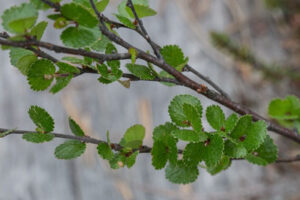
The wide, open central areas of Suurisuo are fens (neva). At this point, the pine bog (nevaräme) transitions into fen. Among the sedges growing here are wire sedge, bottle sedge, and mud sedge. Cottongrass can be seen in tufts on some of the hummocks, while bogbean grows in the wettest spots. The peat layer here is approximately 5–6 meters thick.
Typical birds of this mire type include the wood sandpiper, meadow pipit, whinchat, and the yellow wagtail, which has become rare in southern Finland.
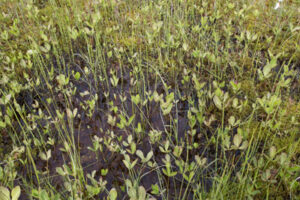
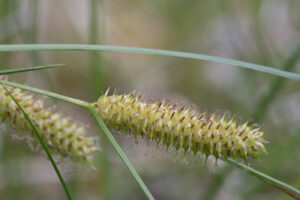
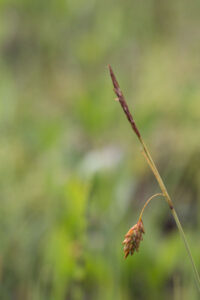
As you move toward the center of the mire, the landscape becomes wetter. You’ve arrived at a flark fen, known in Finnish as rimpiletto. Especially in spring, this area is very moist, but even late into summer, open water remains visible between the vegetation. Plants typical to this habitat include few-seeded sedge (Carex disperma), slender cottongrass (Eriophorum gracile), and hair sedge (Trichophorum alpinum). Near the boardwalks, you might also spot some early marsh orchids (Dactylorhiza incarnata) and alpine rushes (Juncus alpinoarticulatus). Later in summer, false asphodel (Tofieldia pusilla) may also bloom here.
Fens (letot in Finnish) are nutrient-rich mire types, often influenced by calcium from the groundwater. Thanks to this, they are less acidic than other bog habitats. As a result, fens tend to support a greater diversity of plant species, including some rare mire specialists. A flark fen refers to a fen in which open water covers about half or more of the surface area. The rimpiletto in Suurisuo is nourished by spring water flowing in from the southwest edge of the mire, carrying essential nutrients and minerals to the plants.
This is also a great spot to look for “carnivorous plants.”
Sundews (Drosera spp.) trap insects on their sticky, glistening leaves, while bladderworts (Utricularia spp.) use underwater bladder traps to capture tiny aquatic prey.
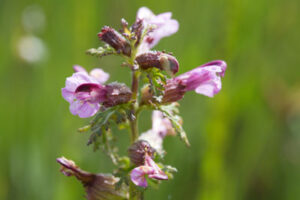
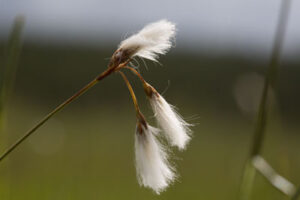
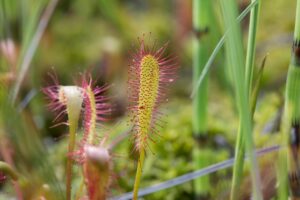
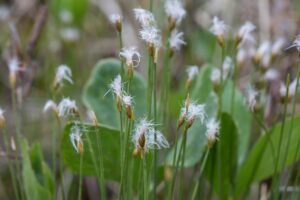
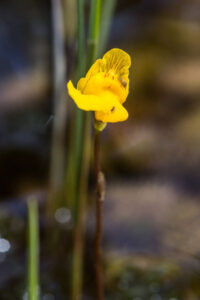
You’ve reached the center of the southern part of the mire, where the boardwalk splits. The path to the right leads toward the heart of the mire. You can walk to the end of the spur and observe birds nesting farther out on the open bog. The central mire is primarily pale sedge fen (kalvakkaneva). Along this spur, you can spot mud sedge, marsh rush, bog rosemary, hair sedge, false asphodel, and flat-leaved bladderwort.
Can you see any cranes or black-headed gulls nesting in the distance?
To the southwest of the junction, early marsh orchids grow. Their numbers vary from year to year, but at their best, dozens may bloom in a single season.
The early marsh orchid has a sturdy stem and a relatively short, oval-shaped flower cluster. It looks quite different from the heath spotted orchid, which can also have a pinkish-purple bloom but is more slender in shape.
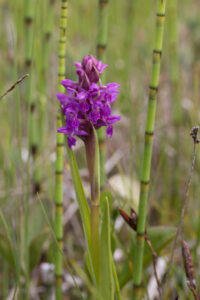
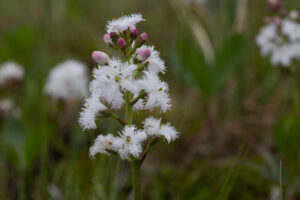
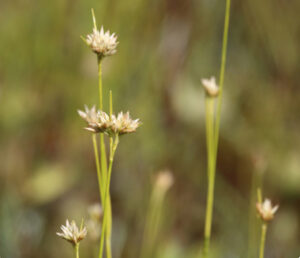
As you continue from the intersection toward the southern edge of the mire, you enter a grass-dominated sedge fen (ruohoinen saraneva). As the name suggests, several sedge species grow here, including slender sedge, mud sedge, bottle sedge, and few-seeded sedge. Other plants include tufted cotton-grass and marsh cinquefoil (Comarum palustre).
Marsh cinquefoil (Comarum palustre) gets its Finnish name kurjenjalka—“crane’s foot”—from its distinctive three-part leaves that spread like the toes of a crane.
In the past, grasses and sedges were traditionally mown from these types of fens for cattle fodder. Today, the area is grazed by moose, though you’re unlikely to spot them during the day—they are most active at night or in twilight.
Compare the few-seeded sedge (Carex disperma) to other sedges in the area, such as bottle sedge or mud sedge. You’ll notice that the spikelets of C. disperma all look quite similar, whereas C. rostrata (bottle sedge), for example, has clearly distinct male and female spikes.
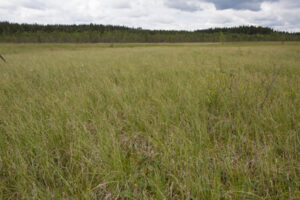
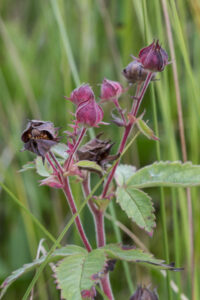
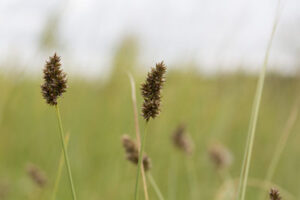
In this area, the dominant plants are Scots pine, and beneath them, hare’s-tail cotton grass (Eriophorum vaginatum) and brown sphagnum moss.
You can distinguish hare’s-tail cotton grass from slender and marsh cotton grasses by its single, fluffy white spikelet. After blooming, the white tufts turn grey and eventually wither. This species grows in dense clumps and contributes significantly to peat formation.
Many sedges and sphagnum mosses also form peat as they decay. In fact, peat is often classified not only by its degree of decomposition, but also by the dominant plant type that formed it—for example, sphagnum peat or sedge peat.
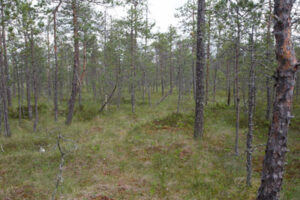
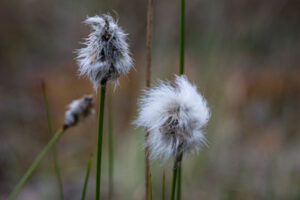
Hare’s-tail cotton grass (Eriophorum vaginatum). In the foreground, a fresher specimen; in the background, greyed individuals whose blooming period has already passed.
 Sphagnum moss carpet in the hare’s-tail cotton grass bog. The brown patches are brown sphagnum (Sphagnum fuscum), which often grows on drier hummocks than other sphagnum species—a useful clue for navigating the mire.
Sphagnum moss carpet in the hare’s-tail cotton grass bog. The brown patches are brown sphagnum (Sphagnum fuscum), which often grows on drier hummocks than other sphagnum species—a useful clue for navigating the mire.
Typical plants of bogs include various dwarf shrubs. When larger shrub species such as Labrador tea, bog bilberry, bog rosemary, marsh Labrador tea, or low-growing willows dominate, the area is called a tall-shrub bog. In this area, patches of tall-shrub bog are primarily formed by Labrador tea (Rhododendron tomentosum) and bog bilberry (Vaccinium uliginosum). When Labrador tea is in bloom, its strong scent fills the bog on summer evenings.
Shorter bog species found here include large cranberry, crowberry, and cloudberry. Along the edge of the mire, you may also find other berry-bearing plants such as lingonberry, stone bramble, and bilberry.
At this point, the peat layer is about 3–4 meters thick; in the central parts of Suurisuo, it can reach up to 8–9 meters.
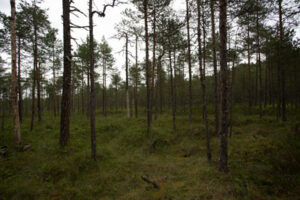

Large cranberry (Vaccinium oxycoccos).
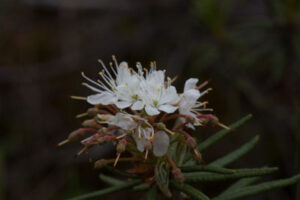
Labrador tea (Rhododendron tomentosum).
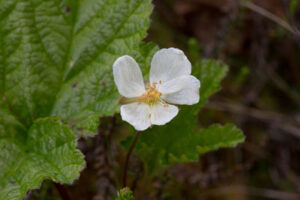
Cloudberry (Rubus chamaemorus).
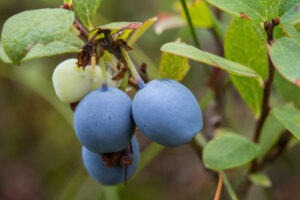
Bog bilberry (Vaccinium uliginosum).
At this point along the trail, you reach the southern end of the mire. The nature trail continues along the western edge of the bog, but from here you can also climb up the slope to Koivistonharju ridge, which has an east–west trail running along its crest. At the base of the ridge, the mire transitions into dry coniferous forest. A typical species here is common cow-wheat, which also grows abundantly on the mire side. Parts of the ridge forest have been logged, and the edges of the clearings are feeding areas for white-tailed deer.
If you follow the boardwalk west, a short side path leads to a natural spring.
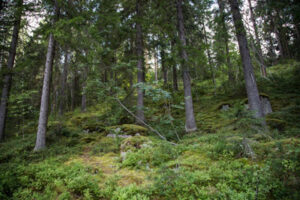
The slope of Koivistonharju Ridge. The slope is rocky in places, shaped by the waves of the ancient Yoldia Sea that once washed over the moraine deposit.
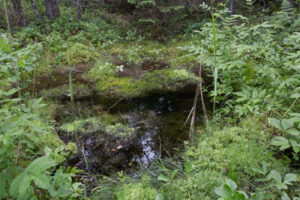
Spring
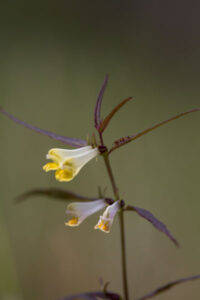
Common cow-wheat (Melampyrum pratense).
The wetlands along the western edge of the mire are fen-type forests (korpisuo), including both sedge fens (nevakorpi) and spruce-dominated swamp forests (kuusikorpi). There are also patches of black alder fens (tervaleppäkorpi). Several natural springs can be found in this area, feeding water into the southern part of the mire. Mosses and herbaceous plants grow in and around the springs.
The vegetation here differs from the drier pine bogs seen earlier: in the fens, taller grasses and herbs, as well as large ferns, dominate the landscape. Typical species include: wood horsetail (Equisetum sylvaticum), male fern (Dryopteris filix-mas), marsh cinquefoil (Comarum palustre), buckbean (Menyanthes trifoliata), common reed (Phragmites australis), lake horsetail (Equisetum fluviatile), tufted hair-grass (Deschampsia cespitosa), creeping bentgrass (Agrostis stolonifera), and reed canary grass (Phalaris arundinacea).
You may also find beautifully blooming Heath Spotted Orchids (Dactylorhiza maculata) in abundance.
From the western end of the boardwalk, a trail leads to a birdwatching tower. The trail crosses through the forest and ascends a hill where the tower is located. From the top, you can overlook the open mire and observe birdlife with binoculars or a spotting scope without disturbing the animals. In spring, black grouse (Lyrurus tetrix) and ravens (Corvus corax) can sometimes be seen displaying from the tower.
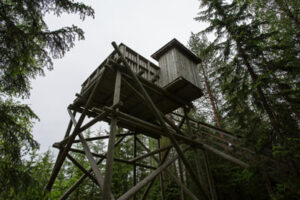
Birdwatching tower
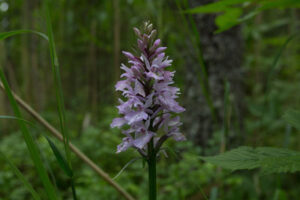
Heath Spotted Orchid (Dactylorhiza maculata).
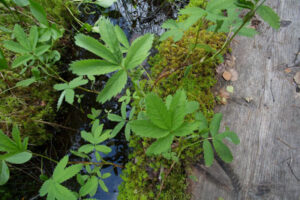
Leaves of Marsh Cinquefoil (Potentilla palustris).
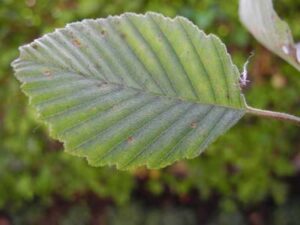
Leaves of Grey Alder (Alnus incana).
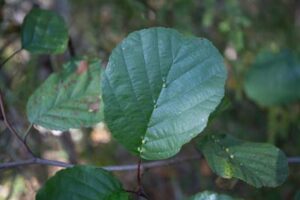
Leaves of Black Alder (Alnus glutinosa).
The tip of the black alder leaf is typically rounded inward, a shape known as emarginate. In contrast, the tip of the grey alder leaf is more tapered. The black alder leaf is also usually noticeably shinier.
This part of the mire is wet, as water from southern springs slowly flows northward through here toward the outflow channel on the western edge. The wettest areas are sedge fens or flark fens. The winding pattern of the fen through the pine bog indicates where water has once flowed more forcefully. Over thousands of years, peat accumulation has covered the channel, and its exact course may have shifted over time.
The edges between the bog and the wetter flow paths often attract a variety of insects, including dragonflies and butterflies. Typical butterfly species of the mire include the Cranberry Blue, the Freija’s Fritillary, and the Fen Grass Veneer.
Mires are typically home to waders and waterfowl. The wetter the mire, the more abundant these bird groups tend to be. Compared to the rich aapa mires of northern Finland, Suurisuo is relatively dry, and thus hosts only a modest number of these species.
Waders regularly spotted at Suurisuo include the Wood Sandpiper (Tringa glareola), Green Sandpiper (Tringa ochropus), Common Snipe (Gallinago gallinago), and the Eurasian Woodcock (Scolopax rusticola) in the surrounding forests. Cranes (Grus grus) breed in the mire, and Whooper Swans (Cygnus cygnus) can occasionally be seen flying over on their way to nesting ponds.
Forest-edge breeders include species like the Black Grouse (Lyrurus tetrix), Hazel Grouse (Tetrastes bonasia), Raven (Corvus corax), and Tree Pipit (Anthus trivialis). Though rare, birds of prey may also be observed.
Hobbies (Falco subbuteo) are agile aerial hunters of insects and may be seen gliding above the mire. From the birdwatching tower, you might spot Kestrels (Falco tinnunculus), Sparrowhawks (Accipiter nisus), or Common Buzzards (Buteo buteo). Ospreys (Pandion haliaetus) are known to breed in the region. In autumn and winter, lucky visitors might catch a glimpse of a White-tailed Eagle (Haliaeetus albicilla) or a Golden Eagle (Aquila chrysaetos) soaring over the mire.
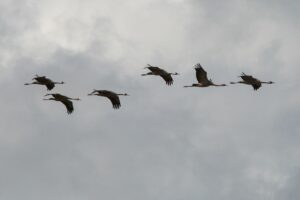
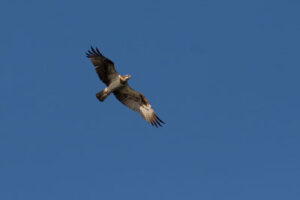
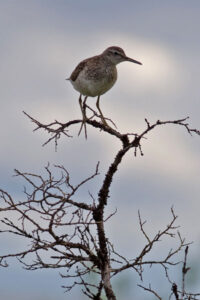
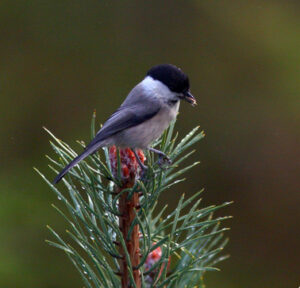
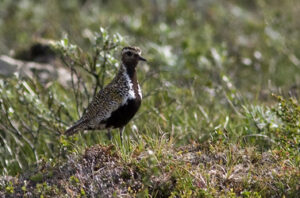
You are nearing the end of the southern loop of the nature trail and approaching the boardwalk crossing in the center of the mire. The bog landscape is gradually replaced by open fen. Shrubs disappear, and vegetation transitions to the characteristic species of the mire’s central zone.
Along the boardwalk, you can spot bogbean, large cranberry, bottle sedge, mud sedge, as well as round-leaved and long-leaved sundews. Sundews catch insects using sticky droplets on their leaves and digest them to absorb nitrogen—an essential nutrient in the nutrient-poor mire environment.
In wetter patches beside the boardwalk, bogbean is easily recognized by its branching flower cluster. In autumn, the bright red berries of the large cranberry bring color to the edges of the hummocks.
